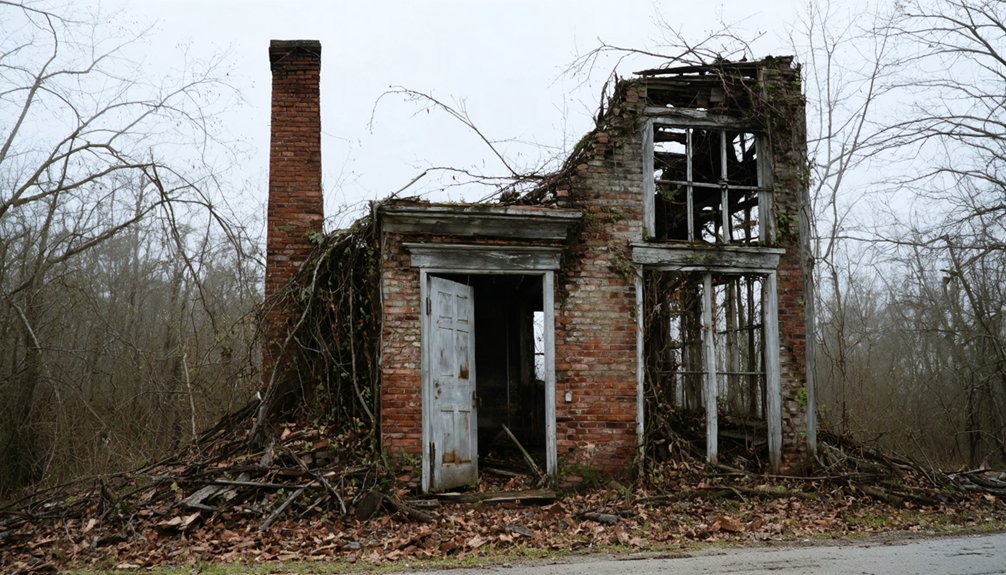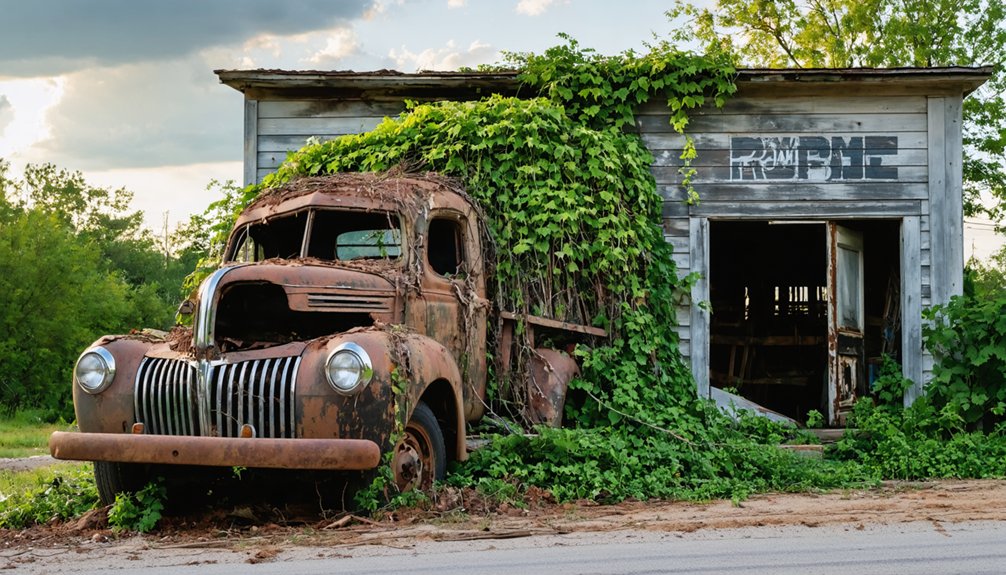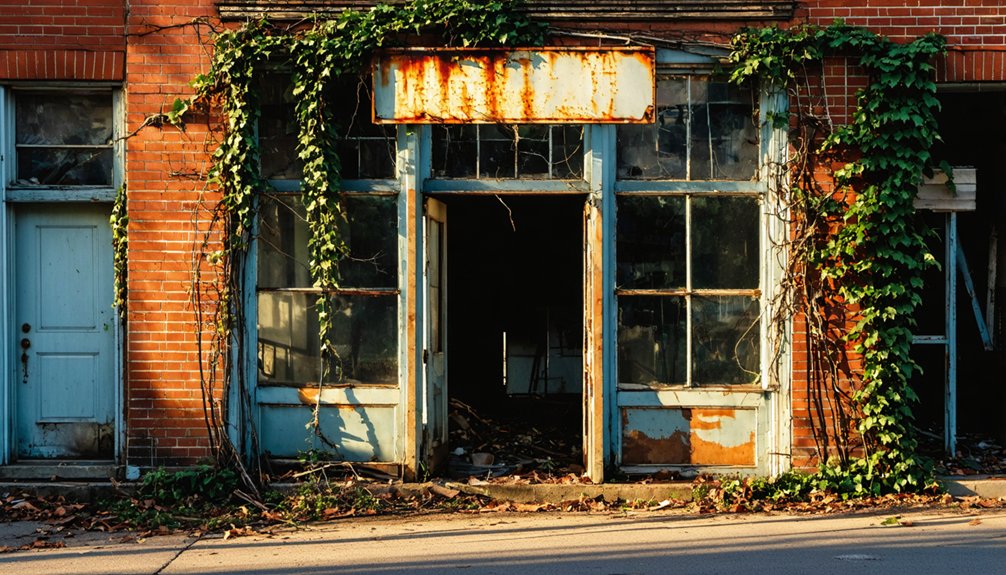You’ll find Arcola’s ruins along Alabama’s Black Warrior River, where French exiles first settled in 1817. After struggling with land surveys, these settlers established a river landing that later evolved into a bustling cotton plantation hub. By the 1850s, wealthy planters like Alfred Hatch had built grand mansions and operated 3,000-acre estates worked by enslaved people. The ghost town’s remaining structures tell a complex tale of cultural transformation and economic change.
Key Takeaways
- Arcola transformed from a French exile settlement into a bustling river port before declining into a ghost town after the Civil War.
- The Alfred Hatch Place mansion stands as one of the few remaining structures in what was once a thriving plantation community.
- The town’s economy collapsed with changes in river commerce and transportation patterns following the plantation era.
- Originally established by French settlers fleeing Napoleon’s fall, Arcola later became a major cotton plantation center along the Black Warrior River.
- Historic preservation efforts focus on documenting and protecting remnants of Arcola’s past, including its plantation-era structures and archaeological sites.
French Exiles and the Birth of Arcola
When Napoleon Bonaparte fell from power in 1815, a group of his loyal supporters fled France to escape persecution under the restored Bourbon monarchy.
These French exiles, including high-ranking military officers and intellectuals, found refuge in the United States, where Congress granted them 92,160 acres in the Alabama Territory.
French military officers and intellectuals fleeing Napoleon’s fall found sanctuary in America, receiving over 90,000 acres from Congress.
After arriving in Philadelphia, the refugees chartered the schooner McDonough to Mobile, then journeyed up the Tombigbee River to White Bluff.
They initially settled Demopolis but faced colony challenges when surveys revealed their actual grant lay a mile east.
Some dissatisfied settlers established Arcola, named after Napoleon’s victory at the Bridge of Arcole, which grew to become the largest settlement in the Vine & Olive Colony.
An estimated thirty thousand Bonapartists sought asylum in America between 1815 and 1817, fleeing the White Terror against Napoleon’s former supporters.
The settlers reached Ecor Blanc by July 14, 1817, where they would begin their new lives in America.
Congress required the exiles to cultivate vines and olives, offering generous terms of $2 per acre payable over 14-17 years.
Life Along the Black Warrior River
Along the Black Warrior River in Arcola, you’d find a bustling steamboat landing where cotton, timber, and agricultural goods were loaded for transport to Mobile’s busy port.
The 178-mile waterway stretches through west-central Alabama, enabling vital transportation that supported towns like Arcola.
You could watch as workers at the landing coordinated the loading of steamboats, while merchants conducted trades and arranged shipments at the riverside warehouses.
The fertile soil near the river supported thriving farms and plantations, where families grew cotton, corn, and other crops while maintaining close ties to Arcola’s river commerce.
The waterway ultimately joins the Tombigbee River at Demopolis junction, continuing its journey toward Mobile Bay.
River Trade and Commerce
The Black Warrior River emerged as an essential commercial artery in 19th and early 20th century Alabama, transforming the region’s economic landscape. You’d find steamboats plying established trade routes between Tuscaloosa and Mobile by 1826, carrying coal, chemicals, steel, and wood to distant markets. The waterway was named after Chief Tushkalusa, reflecting the deep historical connection to Native American heritage.
The river’s economic impact intensified when coal mining operations expanded along its banks, with about 200 people working in the coal trade by the 1840s. Environmental concerns about these operations continue today, as evidenced by the Warrior Met Coal lawsuit in 2022 over unpermitted wastewater discharges.
When Tuscaloosa lost its status as state capital in 1847, river commerce became even more imperative to local survival. You’ll see evidence of this in the federal improvements made from 1888 to 1895, including locks and dams that tamed the river’s challenging shoals and fluctuating water levels, ensuring year-round navigation for the growing fleet of commercial vessels.
Steamboat Landing Operations
Life aboard Black Warrior River steamboats centered around bustling landing operations where you’d witness a complex dance of loading coal, iron, and agricultural goods.
These crucial transfer points reflected the region’s industrial spirit, with nearby coke plant workers ready to assist during emergencies. The coke plant workers demonstrated their vital community role during the 1919 Mary Frances disaster by immediately suspending operations to help with rescue efforts.
You’d have encountered these fundamental aspects of steamboat landing operations:
- Coordinated cargo transfers when vessels ran aground, requiring quick shifts to alternative boats
- Receipt systems tracking shipments and passengers, maintaining order amid challenging conditions
- Year-round commerce activities despite navigation hazards before dam construction
- Emergency response coordination during accidents, involving local volunteers and divers
Steamboat construction made vessels vulnerable to various dangers, from boiler explosions to snags, but the organized landing operations helped maintain essential river commerce despite these risks. Most vessels were side-wheel steamers constructed of wood, making them susceptible to damage from river hazards.
Riverside Agricultural Communities
Stretching across 6,274 square miles of Alabama’s diverse terrain, the Black Warrior River watershed nurtured countless agricultural communities that thrived on its fertile floodplains.
You’d find family farms nestled between the river’s hardwood forests, where farmers adapted their planting schedules to the natural rhythm of seasonal floods. The rich sediment deposits enhanced floodplain agriculture, supporting robust harvests of cotton, corn, and vegetables.
As you traveled along the river’s 180-mile course, you’d witness how communities integrated with the river ecology, from the Cumberland Plateau’s rocky outcrops to the expansive wetlands below Tuscaloosa. The Creek Indian town originally occupied these fertile lands before new settlement began after 1814.
Farmers supplemented their income through timber harvesting and fishing, while the river’s transportation network connected them to regional markets, creating a self-sustaining agricultural economy that shaped life along these fertile banks.
From European Dreams to Southern Reality
While French Bonapartists dreamed of establishing a thriving agricultural colony in Alabama during the 1820s, their vision of cultivating vineyards and olive groves quickly collided with harsh realities.
Their colonial ambitions faced numerous setbacks that ultimately led to cultural assimilation into the American South:
- Land disputes with American squatters threatened French property claims
- Lack of political and economic support from Europe undermined the colony’s sustainability
- Unsuitable conditions made vine and olive cultivation nearly impossible
- River access attracted American planters who gradually bought out French holdings
By the 1850s, the French settlement disappeared as the area transformed into a community of adjoining plantations.
The Rise of Plantation Culture
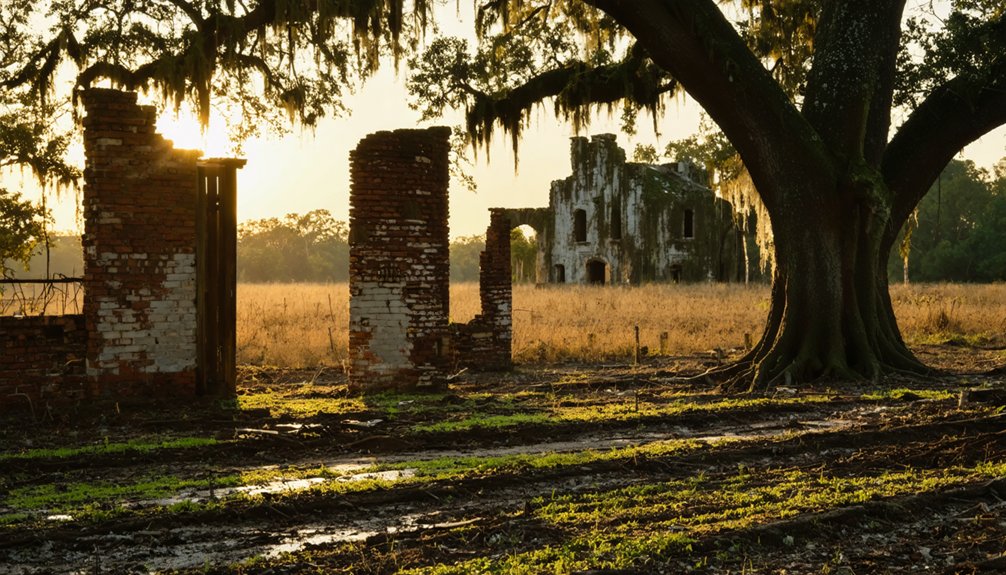
As French settlers relinquished their holdings in the 1830s, a new agricultural empire took root in Arcola. American settlers quickly consolidated the fragmented French land grants into sprawling cotton plantations, fundamentally transforming the area’s character and economy.
You’ll find the most dramatic example in Alfred Parker Hatch’s 3,000-acre estate, established in the early 1850s.
The plantation economy thrived on the forced labor of approximately 200 enslaved people at Arcola alone. In 1856, Hatch constructed a grand Greek Revival mansion, complete with a columned portico and Tudor arch window, as a symbol of his ill-gotten wealth.
The estate served as an operational hub, using the nearby river landing to ship cotton harvested through brutal exploitation.
Agricultural Transformation and Social Change
You’ll find that Arcola’s transformation from a French settlement to a cotton plantation economy mirrored broader changes across Alabama’s Black Belt region.
Early French settlers, who originally hoped to establish vineyards and olive groves, discovered the area’s rich soil was better suited for cotton production.
The shift to cotton farming brought significant social changes, as large plantations emerged and the area’s demographics shifted to reflect the plantation-based agricultural system.
French to Cotton Transition
During the 1830s, Arcola’s agricultural landscape transformed dramatically as French colonists sold their struggling vineyards and olive groves to American planters from the East Coast.
The shift from French viticulture to cotton monoculture marked a profound change in the region’s farming practices and social structure.
You’ll find these major changes defined the alteration:
- Wealthy planters like Alfred Hatch acquired large tracts of land from financially distressed French settlers
- Cotton quickly replaced experimental French crops, enabled by enslaved labor
- The Black Warrior River landing at Arcola became essential for cotton transport
- Plantation agriculture expanded to thousands of acres, with the Hatch plantation alone spanning 3,000 acres by 1856
This agricultural revolution effectively ended the French colonial experiment, establishing a new era of commercial farming focused on cotton exports.
Plantation Society Emerges
While French colonists departed Arcola in the 1830s, a new plantation-based society quickly took root under wealthy American planters like Alfred Hatch.
You’d find plantation dynamics centered on extensive cotton production, with the Hatch family controlling over 3,000 acres and enslaving approximately 200 people for forced labor.
The social hierarchy reflected the harsh realities of antebellum Alabama. Wealthy planter families intermarried to consolidate their power, while enslaved African Americans provided the labor that generated their wealth.
Greek Revival mansions and horse-powered cotton mills replaced the former French colonists’ modest farms and failed vineyards. The shift transformed Arcola’s landscape, as commercial cotton agriculture overtook the earlier attempts at grape and olive cultivation, fundamentally altering the region’s economic and social fabric.
River Commerce and Economic Activities
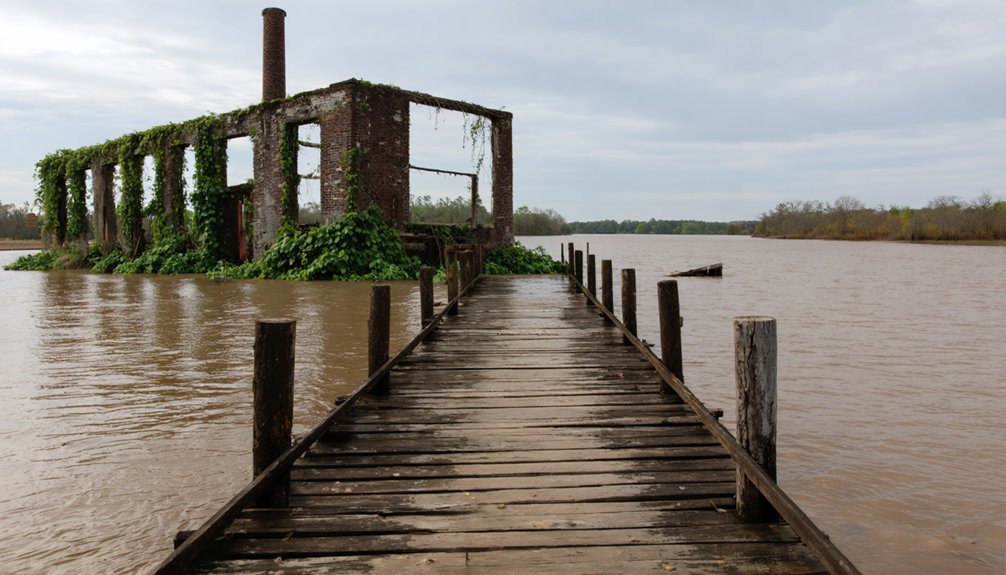
As a thriving river port in the 19th century, Arcola’s economy centered on the bustling commerce of the Black Warrior River.
You’d find steamboats regularly docking at this important trading hub, transforming what’s now a ghost town into a significant link in Alabama’s river economy. The settlement’s strategic location made it an essential stop for vessels carrying:
- Cotton bales headed downstream to Mobile’s busy port
- Sugar and coffee shipments moving upstream to inland markets
- Fuel and supplies for steamboat maintenance
- Agricultural goods from surrounding plantations
The river commerce shaped Arcola’s development, with slaves working the landing sites to load and unload cargo.
Steamboat captains relied on Arcola’s infrastructure for their vessels’ upkeep, making it a key stop along their trading routes.
The Fading French Legacy
Beyond the bustling river commerce, Arcola’s roots trace back to an ambitious French venture known as the Vine and Olive Colony.
Along the river’s edge, Arcola began as a hopeful French settlement, where dreamers planted their Vine and Olive Colony.
You’ll find that prominent Bonapartists, including Count Charles Lefebvre Desnouettes and Lieutenant-General Baron Henri-Dominique Lallemand, established this settlement in the early 1800s with dreams of cultivating Mediterranean crops.
The French heritage of Arcola gradually faded as agricultural challenges mounted. While the settlers brought their distinctive cultural influence, attempting to recreate a piece of France in Alabama, their vision couldn’t overcome the region’s unsuitable climate and soil conditions.
The colony’s ambitious plans for vineyards and olive groves gave way to traditional American plantation agriculture.
Today, only traces remain of this French experiment, including the town’s name – a nod to Napoleon’s victory at the Battle of Arcole.
Archaeological Remnants and Historical Sites
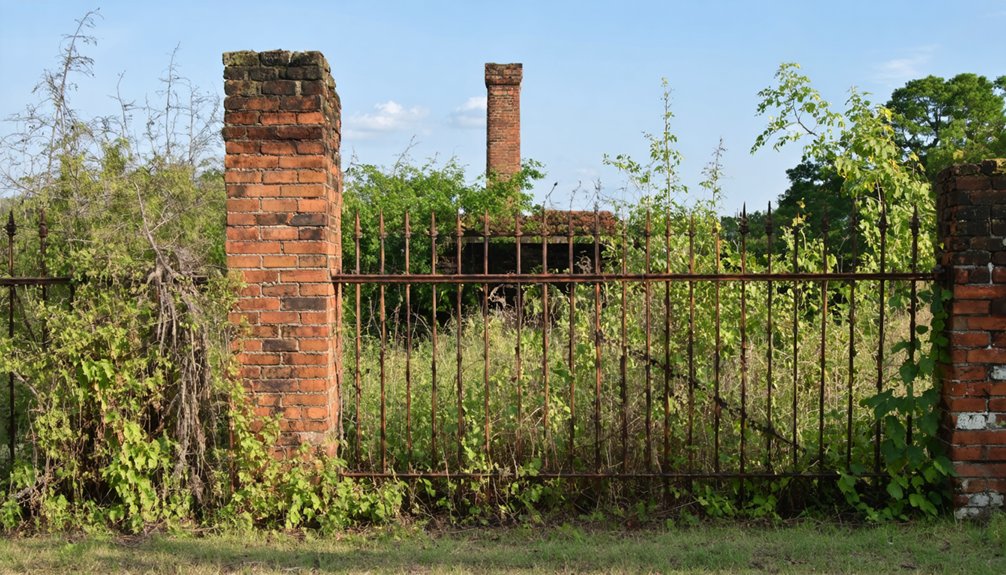
Despite its vanishing presence today, Arcola’s archaeological footprint reveals fascinating remnants of its French colonial past. The site’s archaeological significance centers on key structures and locations that tell the story of this early 1820s settlement, established by former Bonapartists.
You’ll find these historically preserved elements across the landscape:
- The surviving chimney of a former inn, standing as a silent sentinel
- Old Bellefonte Cemetery with gravestones dating to 1826
- The historic river landing that once bustled with trade
- The Hatch Plantation site, originally established by Frederic Ravesies
While fewer visible structures remain compared to sites like Old Cahawba, Arcola’s archaeological remnants provide crucial evidence of French influence in Alabama’s early development.
The site holds potential for future excavations that could uncover more details about this unique French-American settlement.
Preserving Arcola’s Story
The preservation of Arcola’s heritage involves coordinated efforts from multiple organizations and dedicated community members.
You’ll find local historical societies leading community involvement through educational outreach and preservation campaigns focused on landmarks like the Alfred Hatch Place, which gained National Register status in 1988.
Heritage education thrives through school programs, guided tours, and interpretive exhibits that showcase Arcola’s unique Franco-American history.
The Alabama Historical Commission oversees preservation activities while working with volunteers who maintain historic markers and cemetery grounds.
Digital platforms and museums now host collections of oral histories from descendants and local historians.
Archaeological surveys continue documenting subsurface remains, while state grants support ongoing conservation efforts to protect physical features like the surviving inn chimney and Old Bellefonte Cemetery.
Frequently Asked Questions
What Was the Total Population of Arcola at Its Peak?
You won’t find exact population figures, as Arcola’s historical significance wasn’t documented in census records. Despite its early prominence and subsequent population decline, the settlement’s peak numbers remain unknown.
Are There Any Surviving Maps of the Original French Settlement?
Like footprints in the sand, no original maps of the French settlement survive. You won’t find specific cartographic evidence, though historical significance is preserved through broader regional maps and documents.
Did Any French Families Remain in the Area After 1900?
You won’t find any documented French descendants or cultural heritage remaining in the area after 1900. Historical records show the French families had completely dispersed, assimilated, or relocated by then.
What Crops Were Specifically Grown by the French Settlers?
Like seeds scattered in the wind, you’d find the French settlers initially attempted grapes and olives, but when those failed, they switched to cotton, with some small-scale corn cultivation and rice production.
Were There Any Civil War Battles or Skirmishes Near Arcola?
You’ll find several Civil War skirmishes occurred near Arcola, including conflicts at Day’s Gap on Sand Mountain and Cedar Bluff, where Union and Confederate forces clashed during Streight’s Raid.
References
- https://digitalalabama.com/alabama-ghost-towns/arcola-alabama/2798
- https://thebamabuzz.com/5-alabama-ghost-towns-to-put-on-your-bucket-list/
- https://digitalalabama.com/alabama-ghost-towns/alabama-ghost-towns/9449
- https://alabamabucketlist.com/ghost-towns-in-alabama/
- https://kids.kiddle.co/Arcola
- https://en.wikipedia.org/wiki/List_of_ghost_towns_in_Alabama
- https://www.geotab.com/ghost-towns/
- https://www.raremaps.com/essay/164/the-vine-&-olive-colony
- https://npgallery.nps.gov/GetAsset/cfdaae79-4131-4119-8802-f747f7d98fe6
- https://www.floridaolive.org/wp-content/uploads/2021/09/Alabama_Olive-History-2.pdf
